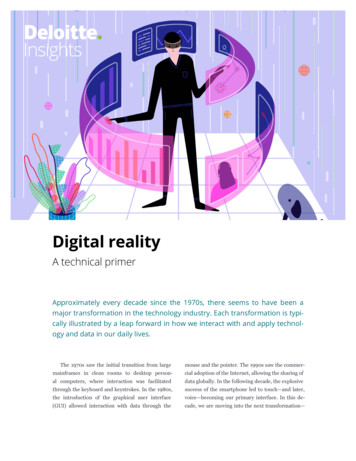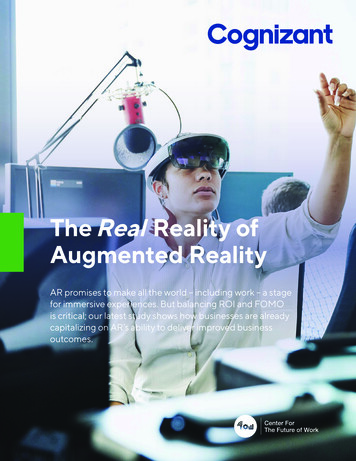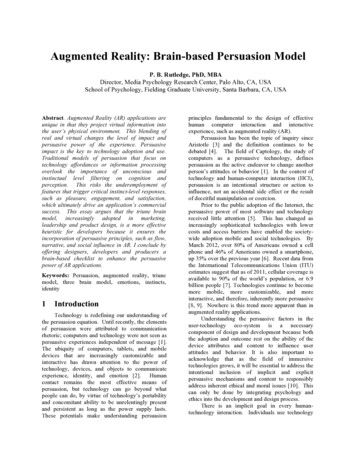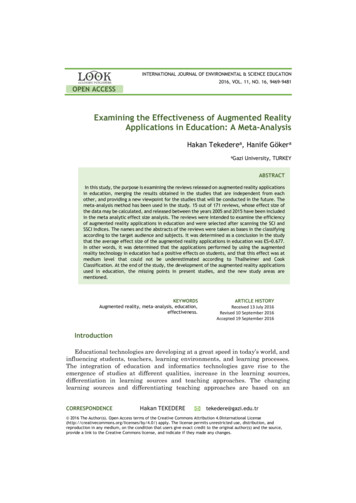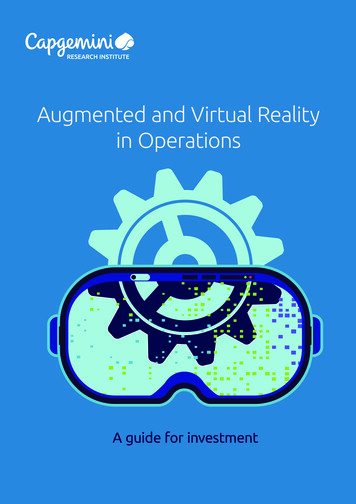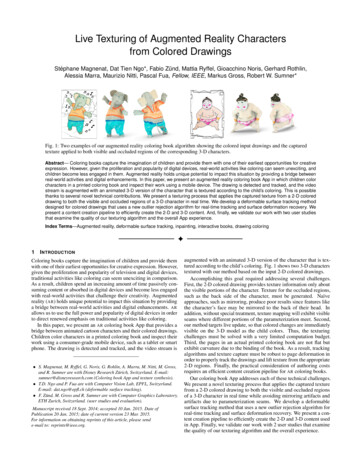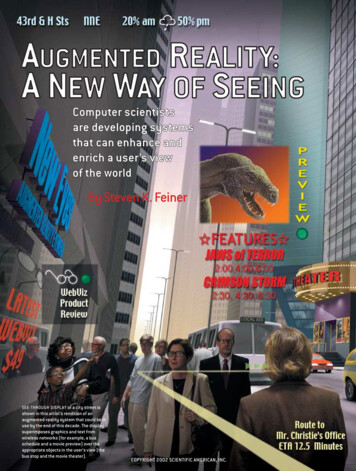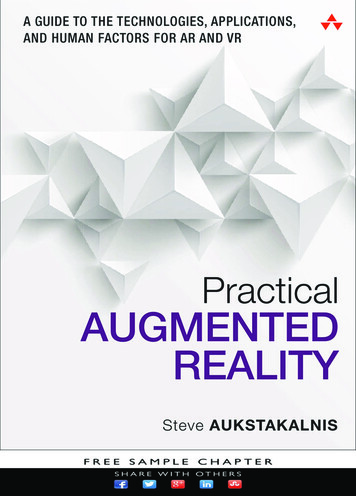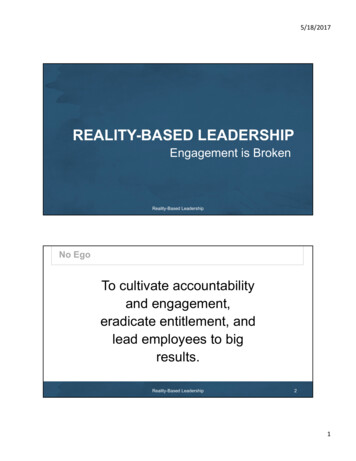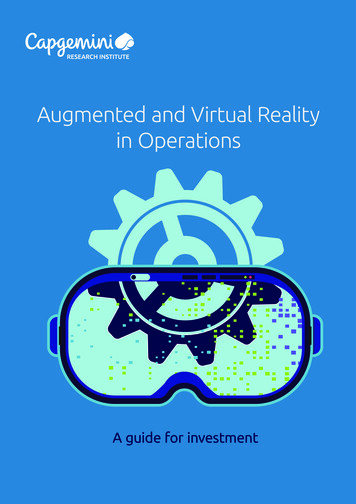
Transcription
Augmented and Virtual Realityin OperationsA guide for investment
IntroductionAugmented Reality and Virtual Reality (AR/VR) are not new,but recent advances in computational power, storage, graphicsprocessing, and high-resolution displays have helped overcomesome of the constraints that have stood in the way of thewidespread use of these immersive technologies. Globalspending on AR/VR is now expected to reach 17.8 billion in2018, an increase of nearly 95% over the 9.1 billion estimatefor 2017.1Given this impetus, we wanted to understand more about thecurrent state of play with AR/VR in the enterprise. We surveyedexecutives at 700 companies, including 600 companies whoare either experimenting with or implementing AR/VR; spokewith AR/VR-focused leadership at global companies, start-ups,and vendors; and analyzed over 35 use cases, with a particularfocus on: The use of AR/VR for internal industrial company operations,including, but not limited to, design, engineering, andfield services The automotive, utility, and discrete manufacturing sectors.This research focuses on organizations that have initiatedtheir AR/VR journey, whether by experimentation orimplementation, and aims to answer a number of questions: How is AR/VR being used today? Where should organizations invest – what are the use casesthat generate the most value? How can companies either begin or evolve their initiatives?Outside of this report, terms you will commonly find whenreading about AR/VR are mixed reality, hybrid reality, ormerged reality in which both the physical and the virtualor digital realities coexist or even merge. In this report, wedistinguish between AR and VR and use the collective “AR/VR”interchangeably with “immersive technology.”Additionally, although applications for immersive technologyare relevant in other parts of an organization’s value chain(sales, customer experience, etc.), for the purposes of thisresearch, we focus on the applications and benefits specificallyin business operations and field services.2Augmented and Virtual Reality in Operations: A guide for investment
Immersive technology has arrived,with AR the more widely practicedBoeing has used augmented reality to provide technicianswith instructions for airplane wiring schematics in their fieldof view, allowing them to be hands-free. This reduces wiringproduction time by 25%, increases productivity by 40%, andeliminates error rates.2Boeing's use of augmentedreality for technicians hasincreased productivity by40% and reduced wiringproduction time by 25%.Ford, on the other hand, uses virtual reality to increasehuman productivity and safety on the assembly line. Virtualreality identifies human movement captured through bodymotion sensors during equipment assembly with the goalof re-engineering movement to decrease risk of injury andincrease productivity. This has resulted in a 70% drop inemployee injuries and 90% reduction in ergonomic issues.3Fieldworkers at Toms River Municipal Utilities Authority(TRMUA), a New Jersey utility, use virtual and augmentedreality to see concealed utilities such as water, gas, electric,and sanitary and storm water sewer utility features. Thisconcept of “seeing through the ground” is possible throughan application that processes data from the geographicinformation system (GIS) that the Microsoft HoloLensultimately turns into a holographic projection of undergroundutility features based on the user’s location and orientation.This innovation increases the productivity of the fieldworkforce on a daily basis and more so under emergencysituations such as fire or flooding.4These examples illustrate how organizations are movingbeyond the hypothetical to pragmatic use. In previous years,organizations focused primarily on educating themselvesabout the technology. Just three years ago, “Companies werewondering ‘what can AR/VR do?’ and ‘where can it be used?’”says Dr. John Ahmet Erkoyunco from Cranfield University inthe UK. The technology has since come a long way. Per ourconversations with AR/VR software providers, the concernstoday are more about ROI and the rate at which software canbe developed.3
What is Augmented Reality and Virtual Reality?To start with, it is important to distinguish between the two technologies:Augmented Reality (AR)Virtual Reality (VR)A digital layer is superimposed on the physical world,integrating the physical, real environment with virtualdetails to enhance or “augment” the real-worldexperience. Experienced with: Smartphones, tablets,smart glasses and other head-mounted displays.Boeing’s technicians use ARinstructions for airplane wiringschematics in their field of view,allowing them to be hands-free.Fieldworkers at Toms RiverMunicipal Utilities Authority(TRMUA), a New Jersey Utility,use AR and VR glasses to seeconcealed utilities lines underthe streets in real-time.At Ford, VR is used to capturehuman movement duringequipment assembly throughmotion sensors to re-engineermovement to decrease risk ofinjury and increase productivity.Creates an interactive, completely digitalenvironment that provides a fully enclosed,synthetic experience incorporating auditoryand visual feedback, experienced often throughthe use of a head-mounted device (HMD).Benefits:Reduced wiringproduction time by orationBenefits:70%Source: Company websites and media articles4Increasedproductivity byAugmented and Virtual Reality in Operations: A guide for investmentDrop inemployee injuriesReduction in90% ergonomic issues
optionRate:27%Superimpose step bystep instructionsEarly design of conceptfully created in VRVirtual walk throughof the siteBoeing technicians workwith AR instructions forairplane wiringschematics in their fieldof view allowingtechnician to behands-free. This cutswiring production time by25% and reduced errorrates to zero.BMW engineers anddesigners use VR to testhow various componentsof a car look whenassembled withoutphysical prototyping. Thisbrings down the cost ofthe engineering processsignificantly.At Pacific Gas andElectric (PG&E), VR andplant data is used toprovide a quicker andsafer way for workers toinspect equipment,lowering the risk oftechnicians getting hurt.Visualize equipment inproduction environmentto see final productVR is used at Airbus tointegrate digitalmock-ups into productionenvironments, givingassembly workers accessto complete 3D modelsof the aircraft underproduction, reducingtime required to inspectby 86%.AdoptionRate:27%Remote collaborationDesigners at Fordcollaborate with eachother across vastgeographic distances tovirtually tour a new vehiclewith the engineering team.This avoids incurring travelcosts.Augmented Reality (AR)RemoteAssistanceStep-by-step instructions while performinga manual taskRemote assistance for support and guidanceVirtual Reality (VR)Equipment design discussion in the virtual worldEmployee using headsets for virtual training5
When will AR/VR become mainstream in your organization?Companies are split on when the technology will become mainstream: 46% within the next three years 53% after three years (see Figure 1).“The impact will not only improve in the next one to three years, but it will also become standard in theautomotive business,” says Frantisek Zapletal, Volkswagen IT.Figure 1. When will AR/VR become mainstream in your organization?Average 46%Average 53%41%38%37%34%16%14%9%7%Less than 1 year3-5 years1-3 yearsARMore than 5 yearsVRSource: Capgemini Research Institute, Augmented and Virtual Reality Survey; May-June 2018, N 603 organizations that areexploring and implementing Augmented Reality and Virtual RealityAR seen as more relevant and widelyimplemented compared to VREven though the use of VR in applications such as collaborativeproduct design can be highly impactful, we found that 66%of organizations believe AR to be more applicable to themthan VR. This could reflect the fact that while AR can alter our6day-to-day interactions with digital machines and systems,VR enhances individual immersive experience by isolatingthe user from the real world. Paul Travers, the CEO of Vuzix,a multinational firm that sells AR/VR wearable technology,agrees. He says that although VR will be big, there arelimitations to what you can do when isolated from the realworld.5Augmented and Virtual Reality in Operations: A guide for investment
By connecting the digital world to the real world, AR supportsa number of breakthrough use cases.6 These involve deliveringtext- and image-based content to workers performing manualtasks and access to real-time remote help from experts on awearable or handheld device. As a result, as Figure 2 shows,more organizations are implementing AR (45%) than VR (36%).Commenting on the applicability of VR relative to AR, “ VR isn’ttoo relevant for us, although we could use it to train peoplewho go to the substations, though there are less complicatedmeans,” says Antti Aarnio, head of Digital Services at Fingrid,a Finnish electricity transmission grid operator. “Especially inour industry, once it passes safety standards, AR could provideadded value for our employees in high-risk situations – forexample, being able to tell if a piece of equipment is underhigh voltage or high temperature.”Companies in the US, China, and Francecurrently lead the implementation raceThe US, in addition to having the most AR implementers(59%), is also expected to be the largest AR/VR spender in2018, at 6.4 billion (see Figure 3).7 Alternatively, the Chinesegovernment and Chinese companies have launched concertedefforts to become leaders in virtual and augmented realitythrough focused research and development efforts, directinvestment, and building human capital.8 France’s marketposition in this space is illustrated by its leadership in VRdevelopment across continental Europe, according to theVenture Reality Fund, a Silicon Valley-based venture capitalfirm focused on early state investments in AR/VR.9Figure 2. Out of companies deploying AR/VR, implementation levels by organization category45%36%64%ARVR55%Out of companies deploying AR, 55% areexperimenting and 45% are implementingExperimentersOut of companies deploying VR, 64% areexperimenting and 36% are implementingImplementersSource: Capgemini Research Institute, Augmented and Virtual Reality Survey; May-June 2018, N 603 organizations that are exploring andimplementing Augmented Reality and Virtual Reality. Implementers: companies with small or large-scale implementations; Experimenters:companies with proof of concepts or pilots.7
Figure 3. Out of companies deploying AR/VR, implementation levels by UKNordicsNordics(Sweden, Norway,Finland)(Sweden, ntersImplementersSource: Capgemini Research Institute, Augmented and Virtual Reality Survey; May-June 2018, N 603 organizations that are exploring andimplementing Augmented Reality and Virtual Reality. Implementers: companies with small or large-scale implementations; Experimenters:companies with proof of concepts or pilots.Immersive technology delivers betterefficiency, productivity, and safetyAR drives higher productivity and efficiency. Manycompanies use AR to streamline workflows by providinghands-free access to immersive step-by-step instructionswhile performing a manual task. With AR, employeescan also remotely collaborate with experts for anytroubleshooting guidance.Dr. Gunter Beitinger, VP of Manufacturing at Siemens,describes how the technology can help in performingquality control for printed circuit boards. “Employees haveto continuously look between a physical circuit board and ascreen to compare, validate, and test acceptable quality,” heexplains. “AR enables those same employees to inspect circuitboards by augmenting their view and calling attention tovarious elements they could have missed.” Using this method,Gunter states, “has resulted in an improvement in quality onthe scale of 20–25%.”8In another example, John Reece, CIO of GE Transportation’sGlobal Services group, outlines how a recent pilot focuseson workers’ maintenance efficiency. “By using AR to viewmaintenance instructions and sign off on tasks withouthaving to go back to their computer, workers performingmaintenance on locomotives were able to increase thenumber of maintenance tasks per hour by 59%,” he explains.John Reece said his group will run a broader pilot in 2018with a larger technical scope including adding contextualinformation to maintenance records through dictation.VR drives increased efficiency and safety performance.Collaborative product design in VR dramatically boostsefficiency. Imagine the case of automotive design – expertsin vehicle safety, styling, durability, and noise, vibration,and harshness located all over the world can collaborativelyresolve conflicts very quickly when simultaneously placed ina fully 3D, immersive design space allowing the interaction ofdesign components. This ability is enabled by using 3D CAD(computer-aided design) data and a virtual reality platform.Without VR, it takes numerous iterations, emails, andmeetings to arrive at a design agreed upon by all parties.Augmented and Virtual Reality in Operations: A guide for investment
VR can also be used in an experience such as a training.Employees who would otherwise be subject to training inharsh, high-risk circumstances can learn and make decisions ina physically-safe environment through VR. The safety factoralone can be enough to justify investment in VR due to thecost of accidents both in training and on the job.1075% Share of organizationswith large-scale AR/VRimplementations that realizeover 10% operational benefitsA large share of companies yield over 10% operationalbenefit with AR/VR. On average, 82% of companiesimplementing AR/VR indicate that benefits yielded from theirAR/VR initiatives meet or exceed their expectations. Figure 4highlights the percentage of companies implementing AR/VRwho are experiencing over 10% operational benefit in areassuch as increased efficiency, productivity, and safety. At least75% of companies with large-scale AR/VR implementationscan attest to operational benefits over 10%.Figure 4. Share of companies with implementations yielding over 10 percent operational benefitsLarge-scale vs. small-scale implementation, AR% indicates the share of organizations deriving more than 10% operational benefits76%35%Large scale implementationSmall scale implementationLarge-scale vs. small-scale implementation, VR% indicates the share of organizations deriving more than 10% operational benefits75%59%Large scale implementationSmall scale implementationSource: Capgemini Research Institute, Augmented and Virtual Reality Analysis; N 152 and 275 organizations implementing at-least twoAugmented Reality use cases at large scale and small scale respectively, N 116 and 220 organizations implementing at-least two VirtualReality use cases at large scale and small scale respectively.9
Where do organizations find valuewith immersive technology?Repair and maintenance is the mostpopular focus of implementation effortsAR/VR is poised to redefine current processes and transformthe value chain. Industry is leveraging this technology acrossfour areas: Design and Assembly: Digitally experience an asset designand operation; test and model changes before completion Immersive training: Immerse an employee in anenvironment to allow decision making in a safe and/ordigitally guided environment Inspection and Quality Assurance: Enable faster,thorough monitoring and inspection through visualizationand information Repair and Maintenance: Use real-time visualizationsand information to assist in completing a maintenance orrepair taskEarly adopters are already implementing immersivetechnology across several parts of the value chain, but theyare more advanced in some areas than in others. Figure 5,which shows the most commonly implemented use casesamong our survey respondents, illustrates the focus on repairand maintenance and design and assembly.Figure 5. A focus on repair and maintenance and design and assemblyRepair and MaintainanceDesign and AssemblyDigital instructions for assembly andconfigurationView reference videosand digital manuals27%31%Simulate product performance inextreme conditionsRemote expert assisstance30%Visualize specific components andfunctions behind physical barriers28%Visualize infrastructure project fromvarious angles30%Superimpose step-by-step instructions29%28%Overlay design componentsonto existing module26%Source: Capgemini Research Institute, Augmented and Virtual Reality Survey; May-June 2018, N 231 organizations that are implementingAugmented Reality; N 175 organizations that are implementing Virtual Reality (some overlap occurs as companies implement both AR andVR). Percentages indicate frequency of use case implementation among all companies implementing AR/VR.10Augmented and Virtual Reality in Operations: A guide for investment
RemoteAssistanceAR yields more benefit and isperceived as more complex than VRFor each sector – automotive, manufacturing, and utilities –we segmented AR/VR use cases according to their relativecomplexity for implementation and the delivered benefits(see Figure 6). This allows us to identify whether use cases fallinto four possible categories: Must do – offer the dual advantage of high benefit and lowcomplexity of implementation Need to do – offer high benefit although with highcomplexity of implementation Can do – offer low complexity and low benefit Do case-by-case – offer high complexity and low benefitAR is perceived as generally more beneficial, if more complexto implement, than VR use cases. On average, only 23% ofthe organizations are implementing high-benefit and lowcomplexity (“must do”) use cases.In the automotive sector, a large share of companies areimplementing “need-to-do” cases that yield high benefit,even if they come with higher complexity. One example fromindustry we heard about was the “digital prototype” or “earlydesign of concept fully created in VR.” Frantisek Zapletal,with Volkswagen IT, spoke with us about the financial benefityielded from one of the Volkswagen AR/VR digital prototypeproofs of concept. He says that “one example is a project inwhich the company used VR to build a prototype that wouldhave otherwise cost 4 million (approximately US 4.7 million).”This use case can be considered an entry-level use case,great for early design phases when the process is not basedon precise CAD (computer-aided design) drawings, hence isof lower complexity. See Figure 6 for other use cases in theautomotive sector.20% Average share ofmanufacturers implementing "mustdo" use cases - the lowest acrossindustries11
Figure 6. Distribution of Use cases, Benefit vs Complexity, AutomotiveLowDigitally track assembling processes for quality assuranceCan DoSimulate various scenarios with digital twin to perform "what if" analysis22%Must Do26%Early design of concept fully created in VRVisualize digital twin to simulate real world environmentSimulate human motion for a process to engineer alternative actionsRemote expert for assistance and guidanceVisualize digital equipment into productionenvironment to see final productComplexityShift perspectives while viewing equipmentRemote collaboration across locations to view same project design and resolveconflict (AR and VR)Virtual walk-through of plantVirtual training for assembling/disassembling componentsAssembly instructions used for trainingView reference videos and digital manualsDigital instructions for assemblyand configurationVisualize digital twin to simulate real-world environmentCompare physical and database version ofHighSuperimpose live data on real machine parts (AR and VR)0%AR30%Visualize specific components andfunctions behind physical barriersDo Case-by-CaseLowVRDigitally view equipment designVisualize historical maintenance recordsand provide task recommendationsNeed to DoHighBenefitAverage no. of companies implementing use cases in this quadrantSource: Capgemini Research Institute, Augmented and Virtual Reality Survey; May–June 2018, N 212 organizations in the Automotivesector that are exploring and implementing augmented and/or virtual reality.Figure 7. Distribution of Use cases, Benefit vs Complexity, ManufacturingLowCan DoMust DoSend digital twin through workflow22%20%Early design of concept fully created in VRVisualize digital equipment into production environment to see final productSimulate human motion for a processto engineer alternative actionsVirtual training for assembling/disassembling componentsDigitally track assembling processes for quality assuranceVisualize digital twin to simulate real-world environmentRemote collaboration across locations to view sameproject design and resolve conflict (AR and VR)Remote expert for assistance and guidanceComplexitySimulate various scenarios with digital twin toperform "what if"- analysisShift perspectives while viewing equipmentVirtual walk - through of plantProject high-res graphics onto equipment for work instructionTraining instructions for assembling/disassembling componentsVisualize digital twin tosimulate real-wotrldenvironmentDigitally view equipment designVisualize historical maintenance records andprovide task recommendationsHigh0%VRDo Case-by-CaseLowARBenefitVisualize specific components andfunctions behind physical barriersCapture images/videos of equipmentfor transmission to another locationOverlay design components ontoexisting moduleTrack KPIs on multiple production linesDigital instructions for assemblyand configuration25%Need to DoHighAverage no. of companies implementing use cases in this quadrantSource: Capgemini Research Institute, Augmented and Virtual Reality Survey; May–June 2018, N 208 organizations in the Manufacturingsector that are exploring and implementing augmented and/or virtual reality.12Augmented and Virtual Reality in Operations: A guide for investment
Few manufacturers (20%) are implementing the “must-do” usecases, which are the low-hanging fruits; whereas the largestshare of implementations is in the “need-to to-do” category.Gordon Schembri, principal at Baker Hughes, a GE company,shared information about GE’s version of a commonlyimplemented use case. “In our industry, you can extract datafrom sensors of live turbines, to construct a digital replica, ordigital twin. Our customers can then run tests on the digitaltwin to find the most efficient and effective way to operatetheir production. Instead of testing on real equipment, whichcost millions of dollars to build and operate, you can run thesame scenario on the digital twin which then informs how tooptimize the workflow,” he says.When data is presented in 3D, rather than abstract form suchas charts and graphs, it is easier to create actionable insightand make decisions. This is why using AR or VR to view thedigital twin in the Baker Hughes example above, is highlyimpactful.Enhancing reality with digital content rather than visualizingin a completely digital environment (VR) is generally morecomplex. See Figure 7 above for other use cases in themanufacturing sector.For the utilities sector, the average implementation level for“must-do” use cases is 24% (see Figure 8). Panu Arvila, whoworks in digital transformation under the Chief DigitizationOfficer at Fortum, a leading clean-energy company operatingin the Nordic countries, Russia, Poland, and the Baltics, sharedone such “must-do” use case. “One instance where we useVR is for training. We have simulations in which we conductradiation protection training for employees participating inFortum’s scheduled annual outage,” he comments. This usecase, specifically listed in the chart below as ‘“virtual trainingfor assembling/disassembling components,” is consideredminimally complex for implementation since training in VRis typically a "beginner" use case where often, accuracy isless critical.This specific use case in the chart above, listed as ‘“visualizedigital twin to simulate real-world environment,” can beAR or VR, although complexity increases in the case of AR.Figure 8. Distribution of Use cases, Benefit vs Complexity, UtilityLowCan DoMust Do0%24%Remote collaboration across locations to view same project design and resolve conflicts (AR and VR)View design models of equipmentVirtual training for assembling/disassembling componentsSimulate various scenarios with digitaltwin to perform “what-if" analysisDigitally track assembling processes for quality assuranceComplexityRemote expert for assistance and guidance360 degree view for utility networkVisualize digital twin to simulate realworld environmentCapture images/videos of equipmentfor transmission to another locationSuperimpose step by step instructionsVirtual walk through of the siteCompare physical and database version of equipmentAssembly instructions used for trainingVisualize infrastructure project from various anglesDigital access to historical maintenance recordsElectronic boundaries forhazardous areasDigital instructions forassembly and configurationHigh26%VROverlay operating detailsonto physical equipmentDo Case-by-CaseLowARBenefitDigitally view components not in physical viewVisualize specific components and functionsbehind physical barriers28%Need to DoHighAverage no. of companies implementing use cases in this quadrantSource: Capgemini Research Institute, Augmented and Virtual Reality Survey; May–June 2018, N 208 organizations in the Manufacturingsector that are exploring and implementing augmented and/or virtual reality.13
“Must-do” and“Need-to-do” usecase examplesBelow are some examples of “must-do” and “need-to-do”use cases. The “must-do” cases are the low-hanging fruit thatdeliver high benefits with low complexity. The “need-to-do,”are use cases that, while complex, can deliver significantbenefits.Examples of these types of use cases, which can be consideredindustry-agnostic, are outlined in Figure 9. For each use case,we identify the top benefits our survey respondents yieldfrom implementing them26% Average share ofautomotive companiesimplementing "must do" usecases - the highest acrossindustriesMust-do use cases (High benefit and low complexity)Need-to-do use cases (High benefit and high complexity)Top benefits based on ourresearchUse CaseExample ApplicationSimulate human motion for aprocess to engineer alternativeactionsFord is using VR technology to identify, and thenengineer alternative actions by humans capturedby body motion sensors during assembling todecrease risk for injury and re-engineer toincrease productivity. This resulted in 70% drop inemployee injuries and 90% reduction inergonomic issues.11- Efficiency Increase- Safety Increase- Productivity IncreaseEarly design of concept fullycreated in VREngineers and designers at BMW use VR tocollaborate effectively by testing how variouscomponents of a car look when assembledwithout physical prototyping. This brings downthe cost of the engineering process significantly.12- Efficiency Increase- Safety Increase- Productivity Increase- Cost SavingVisualize digital equipment pieceinto production environment tosee final productVR is used at Airbus to integrate digital mock-upsinto production environments, giving assemblyworkers access to complete 3D models of theaircraft under production. This reduces the timerequired to inspect from three weeks to threedays.13- Efficiency Increase- Safety Increase- Productivity Increase- Time Saving14Augmented and Virtual Reality in Operations: A guide for investment
Top benefits based on ourresearchUse CaseExample ApplicationVisualize a digital replica or twin"of the equipment to simulate areal-world environmentResearchers at Siemens can use a virtual sensor,based on a digital twin - an exact, functionalsimulation of what a real sensor would do if itwere possible to insert it into a motor. AR allowsthe user to see an exact simulation of the motorand its interior with a real demonstratorsuperimposed over it, illustrating how thesimulation system works.14- Efficiency Increase- Safety Increase- Productivity Increase- Time SavingShift perspectives while viewingequipmentAt Ford, VR enables the viewer to experience thecar from the perspective of a taller man or ashorter woman; allowing the staff to know what’sit like to be in a certain vehicle and from thecustomer's viewpoint.15- Efficiency Increase- Safety Increase- Productivity IncreaseVirtual training for assembling/disassembling componentsAt Enel, staff are trained to perform proceduresand operations to properly service, repair, andmaintain equipment, improving efficiency andincreasing the safety by connecting to VRheadsets. This assures a higher productivity andfewer risks for all employees.16- Safety Increase- Productivity Increase- Efficiency IncreaseRemote collaboration acrosslocations to view same projectdesign and resolve conflictDesigners at Ford collaborate with each otheracross vast geographic distances to virtually toura new vehicle with the engineering team. Thisavoids incurring travel costs and the ability tostay in touch and keep collaborating on vehicledesigns is crucial to their success.17- Safety Increase- Efficiency Increase- Productivity IncreaseSuperimpose step by stepinstructionsAR provides technicians at Boeing withinstructions for airplane wiring schematics intheir field of view allowing technician to behands-free. This cuts wiring production time by25% and reduced error rates to zero.18- Safety Increase- Efficiency Increase- Productivity Increase- Error Rate ReductionCapture images/videos ofequipment for transmission toanother locationEngineers at EDF Energy use Google Glass tocapture images and videos of smart meterinstallations and then transmit these back to acontent management system for review. At thatpoint, an office-based quality as
eden oray inland 49% 51% 57% 43% 58% 42% 67% 33% 72% 28% 77% 23% ina ordis eden oray inland A rane UK AR Figure 3. Out of companies deploying AR/VR, implementation levels by country Source: Capgemini Research Institute, Augmented and Virtual Reality Survey; May-June 2018, N 603 organizations that are exploring and implementing Augmented Reality .
